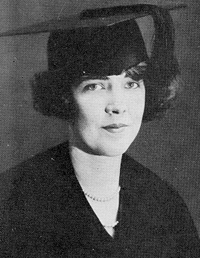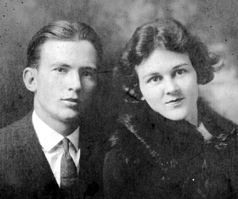Oral History Interviews with First Day Students
Pine Cones grow into big trees
Dr. Bobby H. Johnson has recorded the memories of hundreds of East Texans over the past quarter of a century. He has used much of this material to produce several dramatic presentations under the general title, "East Texas Remembers." With the assistance of the Center for East Texas Studies, he is currently preparing a play on the history of SFA, scheduled for presentation in the spring of 1999. Dr. Johnson's first interviews were conducted in the summer of 1970. Little did he know that his work, starting with the great East Texas oil boom of the 1930s, would grow into an extended talk-a-thon with the entire region. (JLJ)

I have always liked to talk to people--and my training as a journalist somewhat prepared me for a career as an oral historian, but little did I know that it would lead to hundreds of hours of tape-recorded interviews with all kinds of people on a variety of topics, ranging from the Great Depression to World War II.
One of the most satisfying aspects of my research has concerned the history of Stephen F. Austin State University, where I have been a history professor since 1966. To see the place through the eyes of those who participated in its history has been an enlightening experience.
I remember talking with one of the members of the 1925 graduation class . . .
Ruth Fouts Pochmann, now deceased, had vivid memories of Nacogdoches during the early part of the twentieth century. She lived in a house which stood on the site of the present Hotel Fredonia, attended public school here, and went on to become a talented writer and raconteur of those early times. She was present when Stephen F. Austin State Teachers College opened in the fall of 1923 on the Nacogdoches high school campus. Although she had attended Southern Methodist University for three years, family matters brought her home to Nacogdoches in time for that momentous event. Citing the community's support for the opening of a state institution here, she said everyone seemed to realize the impact that the school would have on Nacogdoches and the entire East Texas region. As she recalled the "beautiful pine grove" which grew into the campus on the city's northern edge, she said it offered a great "cultural advantage" for Nacogdoches.
In addition to her own scholarly pursuits, Mrs. Pochmann served as a student assistant and teacher of Spanish in the school's sub-college department; the sub-college was necessitated by the fact that many young East Texans of that era were unprepared for college work. She fondly remembered Dr. Birdwell--"he was SFA"--and a flurry of school activities that ranged from her social club to campus athletic events. A young English instructor also drew her attention, and she later became Mrs. Henry Pochmann. He went on to become a distinguished English professor and noted scholar at the University of Wisconsin. But, they never forgot those early days at SFA.
Just this month, I talked with Otis B. Floyd, another early student who now lives in Nacogdoches after fifty years as a public school teacher. A native of East Texas, Floyd entered SFA in the fall of 1923 (his student activity card, signed by J. H. Wisely, reveals that he was student number 68). Although he was a few credits shy of the requirements, Floyd was able to enroll, along with his older brother, Austin, who was student number 67. "He was standing in front of me at registration," Floyd noted. A math major, he attended SFA for a year or so before going out to teach. He received his degree in 1929. One of his fondest memories was the time he and another student "accidentally" stunk up the Austin Building with a chemistry experiment
"SFA was out in the country," Floyd recalled as he described the early campus. "During the Christmas break in 1923, my brother and I helped with the paving of North Street," he said, "We hauled bricks," he added. He, too, walked to school from his parent's home on Orton Hill. His favorite teacher was math instructor C. E. Ferguson, whom he described as "the cream of the crop." He also cited Dr. W. T. Chambers ("a lot of fun in class") and kindly Bob Shelton, whom he assisted in volleyball classes. Some of those early teachers must have inspired him because Floyd spent a half century as a teacher himself.
Ruby Petrie was at SFA that morning of September 18, 1923, when Birdwell held SFA's first assembly on Washington Square. She is 93 now and had nearly a decade of early SFA memories to recount.
"I was living with an aunt for three years in Timpson when I got my diploma in 1923." No body else in either side of her family had ever been to college. Her brother and her father pooled their money to send her to SFA. "I always wanted to be a teacher, and I thought well, if I'm going to be a teacher, I have to go to college. It was just always my ambition. . . .I came to SFA the first year it opened. Actually, it [the Austin Building] was not open the first semester. We went to college on the high school campus. . . I roomed with one of the girls from Timpson who I graduated with . . . We stayed at a house on Mound Street, the private home of Mr. and Mrs. John Byrd. It was not a boarding house."
"We used the old Keachi College building [Old University] for some of the classes. I never had a class in the Old Stone Fort." Her memories of the "Shack" were vivid.
"It was our study hall. Dr. Birdwell and Miss Mays had their offices there. . . .As best I can remember, it was on the edge of the campus, north of the Old University. . . .Well, since they had the study hall in there, we were prone to listen to what was going on because you know, the best I can remember, the wall that separated his [Birdwell's] office from the rest of the room was open above. Even if he closed the door, we could still hear. It was just a simple room; that is why it was called the 'shack'. . . .We all loved Dr. Birdwell, because he knew every student that first year. He always made us feel that we were free to come to his office if we had any problems. I think most of the problems the students had were with Miss Mays. She was an old maid, and she was so strict. She would not allow three to ride in the front seat of a car. . . .That was too close to a young man . . . which usually there was. I did not know any women at the time who had their own car."
Nacogdoches was a pleasant place, she said; the people were nice. When asked what they did for entertainment, she responded. "If you did not have to study, we would go walking in town. So many of us came from smaller towns in the country. There were not many things to do for entertainment, so we would just go walking." At Christmas of 1923, she met her future husband, Morgan Flournoy. He lived in West Texas, but he had many cousins in East Texas, especially Chireno. The Flournoy family built and lived in the Halfway House there.
"My roommate and I had gone to town. . . .Morgan's cousin was working in a shoe store at the time. As it happened, Ruth and I knew him, in fact, we knew nearly everyone in town. Morgan was talking to his cousin, standing on the street there; he had just come from west Texas. And so, since Chester knew Ruth and me, he introduced us to Morgan, and Morgan said, you know, I have seen so many pretty girls since I have been here. I think I will go to college, too."

Morgan Flournoy decided instantly that SFA was the place for him. Since he had had somw college work, at the end of his first semester, he took a job near Timpson. Since it was a two teacher school, he immediately recommended Ruby for the other post, she got it. "I had planned to go ahead to get my degree....but he made it sound so good." After teaching one year in the country school, the two teachers got married. "Every summer we came back to SFA. We would teach during the year, and pay our debts, and save enough to go to school in the summer. It took me eight summers after that to get my degree. . . .Morgan decided to take one year off from teaching. So he could become a superintendent. He went full time one year. He graduated in 1929; I graduated in 1932."
Currently, at age 93, Mrs. Flournoy is still teaching. "I am a volunteer at the adult learning center in Huntington. I love teaching." She is working with an hispanic lady who has never had a day of schooling in her life; she had to teach her the a, b, c's. The products of the Birdwell school learned their lessons well and continued to pursue them.
These, and other memories, capture the spirit of those early days at SFA when traditions were waiting to happen among the pine trees of East Texas. Now, some seventy-five years later, they serve as reminders that pine cones grow into big trees.